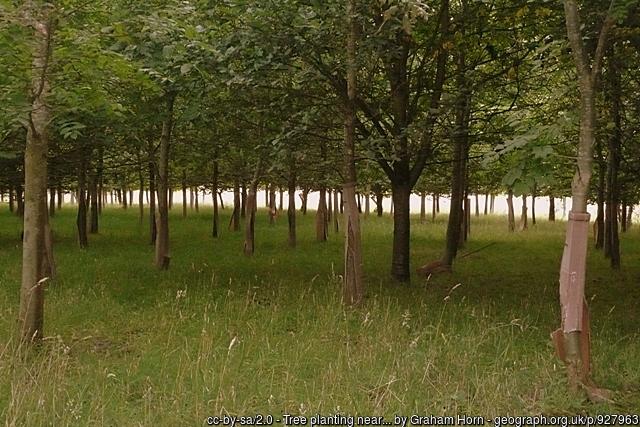
How much is enough forest?
Thursday, 28 November 2019
How credible are the parties' plans for mass tree-planting in the UK? The numbers sound big, but what does "big" really look like in forestry terms? What are the costs and impacts?
The UK is one of the least forested countries in Europe. Afforestation can serve the double purpose of providing a productive (if low-value) use for land and sequestering carbon. But it's not free - if it were the best use of the land, people would already be doing a lot more of it.
In the give-away election currently under-way, where politicians are competing to spend taxpayers' money to prove how "virtuous" they are, there have been a series of bids from the parties for how many million (m) trees or hectares (ha) of forestry they intend to plant.
- Conservatives: 30m trees (30,000 ha) p.a.
- LibDems: 60m trees (40,000 ha) p.a.
- SNP: 60m trees, of which 30m in Scotland p.a.
- Greens: 70m trees (70,000 ha) p.a.
- Labour: 300m trees by 2025, 1 billion (bn) by 2030, and 2bn by 2040
Not surprisingly, these proposals have been treated with varying degrees of scepticism, and the Labour figure has come in for particular scrutiny, e.g.
Equally unsurprisingly, this has provoked a fury of responses from proponents and opponents. This was one of the more measured ones.
Why so sceptical?
BBC journalists may have been led to scepticism by work that their colleagues had done previously. In 2017, their Reality Check series challenged the idea that the Conservatives would plant 11 million trees in 5 years as promised in their 2015 and 2017 manifestos. 11 million had been planted from 2010 to 2015, but the article contrasted:
In 2015-16, 642,000 trees were planted in England. In 2016-17, it was 802,000.
Hundreds of millions sounds like a big ask compared to that. But those figures are misleading.
Getting it in proportion
1. England is not the UK. It might be the biggest part economically, but in terms of forestry, Scotland dominates. If we check the Forestry Commission's Forestry Statistics 2019 (Chapter 1, Table 1.13), England accounted for around 15% of new planting and 20% of restocking (re-planting of felled forest) in those years. So the UK would be around 4m trees p.a. on the basis of the figures quoted for England.
2. There is a tension between the number of trees that the BBC quoted and the area planted/restocked, according to the Forestry Commission, of around 23,000 hectares p.a. Planting densities are typically in the range 1,000 - 2,500 per hectare, with a bias to the top end. Let's say 2,000 per hectare. That's 46,000,000 trees p.a. (These are gross figures - millions of trees are also being felled each year, but in recent decades in most of the West there has been a net gain.)
The explanation appears to be a form of political Chinese Whispers. The Environment, Food and Rural Affairs Select Committee held an inquiry in 2016 on Forestry in England. It was reported to them that planting in England had slumped particularly badly in the period immediately before the inquiry, to only 700 ha. Such a small area gave a similarly small number of trees. This was widely reported as a crisis in the general rate of tree planting and the government's plans, whereas it seems in reality to have been a brief anomaly in England amongst a wider, shallower but still brief hiatus across the UK. The average rate of planting is an order of magnitude higher than that anomaly suggested, at around 23,000 ha p.a. across the UK.
So we should reasonably assume the current run-rate is around 46m trees planted p.a. in the UK (gross).
3. The UK has been "unambitious" by the standards of comparable nations. The following are very rough estimates based on information found online, and assuming the average density of established forests is around 1,500 trees per hectare, but the planting density is around 2,000 trees per hectare (because thinnings, selective felling, mortality etc will reduce the density as forests age).
| Land area (km2) | Forest area (km2) | No. of trees (m approx.) | (Re)plant area (km2 p.a.) | (Re)plant nos. (m p.a. approx.) | |
| France | 550,100 | 175,790 | 26,370 | 2,000 | 400 |
| Germany | 348,770 | 114,190 | 17,130 | 1,500 | 300 |
| Sweden | 407,340 | 305,050 | 45,760 | 4,000 | 800 |
| UK | 242,510 | 31,640 | 4,750 | 234 | 46 |
| EU | 4,246,940 | 1,819,180 | 272,880 | 23,650 | 4,730 |
| USA | 9,160,000 | 3,100,950 | 465,140 | 40,000 | 8,000 |
So Sweden may be planting around 800 million trees a year, while the USA may be planting around 8 billion trees a year.
How do the proposals compare with reality?
The UK will not do anywhere near that, because its land area is smaller than these comparators, and the proportion of that land that is forested is much lower. But it's not hard to imagine increasing the planting rate to around 60 million trees p.a. from the current level, and modestly increasing the area of forested land from the current 13% (across the UK, 10% in England).
The Conservatives look distinctly unambitious with a target rate well below the recent run-rate.
Labour's short-term ambition is also the achievable 60m p.a. Their medium-term ambition requires 100m p.a., which is more of a stretch, but not incredible. It does imply, though, that a meaningful (though still relatively small) proportion of land will be converted from its current use to forestry.
How much land would we need?
If we assume that felling continues at around its current rate (to assume an acceleration would contradict the aim of the policy, which is to sequester carbon), then most of the planting must be new planting, not restocking. That's around 30m trees (15,000 ha) for restocking and 70m trees (35,000 ha) for new planting p.a.
Over 15 years, plus the smaller increases in the first 5 years, that's around 630,000 additional hectares of forestry. That's around 2.5% of our land converted to forestry. As substantial parts of our land are not suitable for conversion to forestry (urban areas, unsuitable terrain, elevation, etc), that is a larger proportion of the cultivable land.
It would have a meaningful impact on land values and on the competing uses for the land (e.g. agriculture), but probably not a dire impact. Given the poor current prices for agricultural produce, it may be a useful rebalancing in land-use, which could benefit land-owners if they are not determined to continue with their current use.
Not all big numbers are equally credible or incredible. This big number in Labour's manifesto is a bit of a stretch but far from incredible. That says nothing about the credibility of other big numbers in manifestos. But it does say that those whose gut told them this was just another Labour over-commitment probably picked the wrong target.
How much would it cost?
What this analysis does not assess (yet) is the cost. If it needed no encouragement, then land-owners would already be doing it. It costs a few thousand pounds a hectare to plant forestry. There are some maintenance/management costs, and a long wait for income, with a material risk of disease or fire before that is achieved. It is likely that land-owners will need incentives in the thousands of pounds per hectare to switch to forestry at large scale. We would need to do more work on this aspect to put a more accurate figure on it. The first impression is that the cost p.a. would be relatively modest compared to many of the other pledges by the parties.
That is to incentivise land-owners to plant trees. The cost would be around quadruple (including land-purchase cost) if Labour were determined for these forests to be state-owned, as they are for other sectors of the economy. That could take the cost of Labour's policy up from low hundreds of millions of pounds per year to around a billion pounds per year.
How much should it cost?
If all of these planting rates are achievable, how do we know which is the efficient option? It is not the case that the highest planting rate is automatically the efficient rate. At some level, the cost (e.g. the opportunity cost of whatever else the money could have been spent on, or the welfare cost of the impact on the economy of raising the taxes to implement the policy) and impact on other uses exceeds the environmental benefit.
The answer, as always is that the efficient level is better discovered than arbitrarily chosen for political reasons. The environnmental benefit of sequestration should be "internalised" via a carbon pricing mechanism that places an equivalent value on this as on other carbon-negative (sequestration) or carbon-neutral (e.g. renewables) options. We would then discover how much tree-planting is the efficient amount. It probably wouldn't be any of the numbers chosen by the parties, because we can never have sufficient knowledge to calculate emergent values like this.
Related blogs



